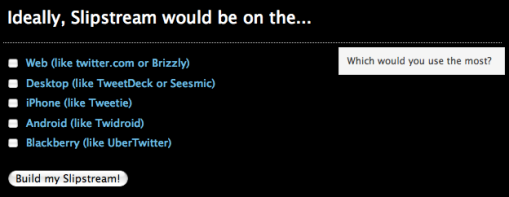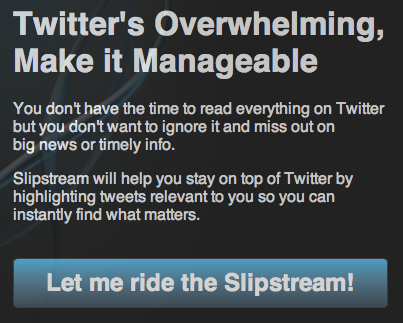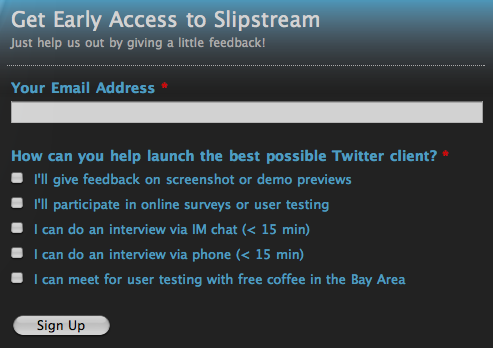Is Your Landing Page Just Collecting Email Addresses?
Most new product landing pages suck because they miss out on opportunities to learn more from people. Your page can articulate a great value proposition with clear benefits, strong credibility, clean design, and the perfect call to action but it’s lacking if all you’re doing is capturing a stranger’s email. How much can you really learn from an email address?
I believe the perfect landing page for a new product is somewhere between a single field form and a survey. No one likes answering a ton of questions but that doesn’t mean all you should ask for is an email address.
So how can you improve your next landing page? Here’s my approach:
- Figure out the next critical thing you need to learn from potential users.
- Pick a way for you to learn what you need directly from your landing page. If you can’t, let your landing page be the first big step to learning.
- Attach the approach you came up with at the end of your landing page funnel. This usually means adding it after you ask for an email address.
Example 1: Figuring out which platform to build on
The following is from my first landing page for Slipstream, a new Twitter client that fixes information overload by highlighting tweets relevant to you. At that time, my most critical question was: “which platform should I build on?” I started with the typical approach, just asking for an email address. The problem is that most landing pages stop here:
If visitors are compelled enough to put in their email address, why stop there? Ask for more information! After people provided their email, they saw the following:
The second form directly asks my critical question: which kind of Twitter client should I be building? I find this data to be more reliable because it’s from people who’ve already shown enough interest to provide an email address. A public poll is easier to game and there’s less weight behind each vote.
The conversion rate on Form 1 was 7%. The conversion rate on Form 2 was 63%. More than half of the people who expressed interest in my product were willing to share more information at the first point of contact. This wasn’t in an email I sent them minutes or months later, it was as soon as they decided they wanted my product. Judging by later response rates from the same group, I’m certain much less than 63% of people would have answered if I asked the same exact question at a later time.
Why was the conversion rate so strong for Form 2? People were already invested in the product after providing their email so they were more likely to participate. I’m just continuing to engage them; not in a follow-up email some time later but with a small, actionable item now. A simple question at the right time takes them seconds to answer and gets me so much more insight than a cold email address.
Example 2: Recruiting collaborators, not users
Here’s another example from Slipstream. I needed to find users who would collaborate with me in building a better product, not just sign up, try once, and disappear forever. I can’t make people give feedback when I need it but I can set up that expectation right from the start with my landing page. This is a case of the landing page being “the first big step to learning what you need,” #3 above.
The first page people see includes a prominent call to action:
When people click “Let me ride the Slipstream!”, they see:
I’m still using two pages because the transition from Page 1 to Page 2 still approximates interest, similar to people giving their email in Example 1, Form 1. I can measure how many people care about my product (click the Page 1 call to action) and how many want to help (fill out Page 2) without worrying about scaring people away with too many questions up front.
As a side note, the second question on Page 2 was directly inspired by an excellent post by Cindy Alvarez with lots of other detailed information for finding people at an early stage.
The conversion rates weren’t as strong as Example 1 but almost 20% of people who came to Page 2 filled out the form. I’m still happy with the results and knowing that I’m getting signups for a very active beta.
How far could you take this?
If people are willing to give you all this helpful information, what’s the limit on how much you can ask? How much more will they answer after providing their email? That might make for a nice experiment but I chose to focus on the one critical thing I really needed to learn next instead of testing people’s patience with a series of forms. After all, when’s the last time you enjoyed filling out a long survey?
If you really want to ask that many questions, you should consider user testing, phone interviews, or face to face meetings. The qualitative feedback you’ll gather will probably give you richer answers than shallow survey data, where it’s harder to ask follow-up questions and nearly impossible to gauge the emotional tone of the answers.
Conclusion
Are you learning as much as you can from your landing page? Don’t just ask for an email address, engage your audience right after they provide their email! Base your engagement on the one critical thing you need to learn next. The conversion rate should be strong because people are already invested after providing their email. Finally, don’t abuse people by asking too much, stick to what you really need to learn.
What are you waiting for? Go learn more from your landing page!





Thanks for the refreshing take on landing pages. I like the idea of keeping the user engaged for a dual purpose: you collect more information, and also the user is more likely to recall your service when they get a signup email in their inbox. For the most part, early signup forms I see only include an email field, but once in a while I also see a short survey with a nonsensical question or silly answers to get a chuckle from the user. Another addition I’ve seen more frequently is connecting to the user’s twitter or facebook streams and drawing in interest from their friends. This doesn’t give you more information like a survey does, but it does allow you to have a greater sample size to work with.
Art,
I don’t mean to be self promotional, but it kind of goes back to Sean’s original question “What can you really learn from an email?”. We’ll, obviously I’m biased but using http://www.flowtown.com (disclosure: I’m a co-founder) you can learn a lot.
Ex: Age, name, location, occupation, and up to 50 different social networks they’re on.
I recently wrote how we use it in our Customer Development (CD) process – and continue to do so daily.
http://www.danmartell.com/3-ways-we-use-flowtown-for-customer-development/
Again, sorry if this comes of the wrong way – just trying to help everyone extract as much value as they can from their efforts.
P.S. It looks like you’re using wufoo? Check it out
Great post!
Co-Founder
@danmartell
@Dan Martell
Dan,
Glad to hear from you! I was waiting for you or someone from Rapleaf to jump on “What can you really learn from an email?” I completely agree that something like Flowtown actually helps you learn a lot. I just really want to encourage people to ask their own questions in addition to relying on automatically gathered data. Someone can always go back and run the emails they’ve collected through your service but as I said in the post, they might be losing out on some great information if they didn’t ask for it directly on their landing page.
Thanks for sharing your process. I especially like the “Real Time Notifications of Target Users” feature! The Wufoo integration also makes a lot of sense.
Dan, this is great stuff. As I’m about to embark on a new landing page, this was very timely for me. Gave me something to think about
Matt,
Glad that I could help! … re: building landing pages, be sure to check out Performable.com or Unbounce.com – both awesome products and great teams.
DM
You should credit Cindy Alvarez’s “Customer Development Interviews How-to: Finding People” at http://www.cindyalvarez.com/best-practices/customer-development-interviews-how-to-finding-people for the second page of questions. Her post not only includes the landing page questions but has a wealth of practical tips for leveraging adwords, facebook ads, tweets, twitter search, google alerts, and example e-mail and twitter templates for how to ask for an introduction.
@Sean Murphy
Good call, I updated the section on Page 2 above.
Nice post Arthur!
I like this a lot !! – It’s so obvious when other people point it out to you. I certainly fall into the old trap of “splash” page !!! I am launching a new site soon and I think it will be good to put something up now to get ‘registered’ in Google and collect eraly adopters. Well Done !!